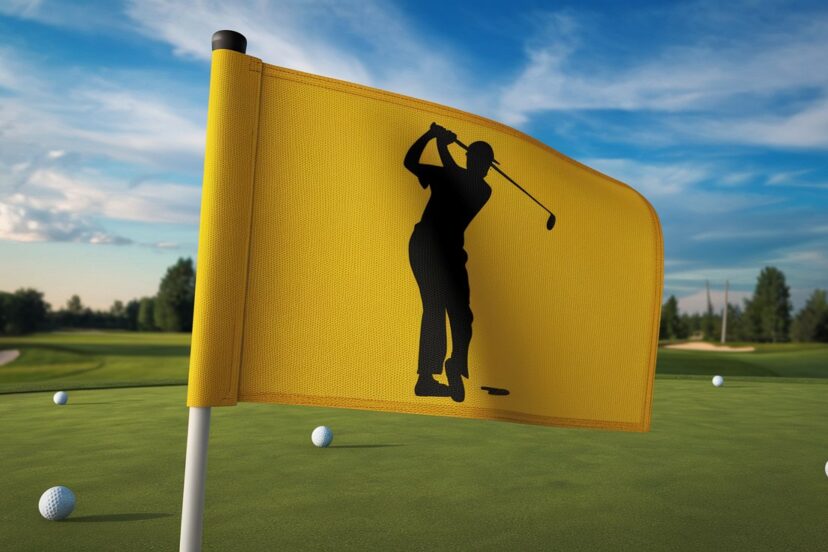Golf Flags: Essential Guide for Every Golfer
*We may earn a commission for purchases made using our links. Please see our disclosure to learn more.
I’ll never forget the first time I truly appreciated a golf flag. It was during a foggy morning round at Pebble Beach, where the vibrant flags pierced through the mist like beacons, saving my round from disaster. Since that day, I’ve paid much closer attention to these essential course markers. From their practical function to their technological evolution, golf flags deserve more recognition than they typically receive.
Key Takeaways
- Golf flags serve multiple functions beyond marking hole locations, including providing distance information and enhancing course aesthetics
- Modern flags incorporate technology like reflective materials, RFID chips, and weather-resistant fabrics
- Flag colors and patterns communicate important information about hole locations and course layout
- Quality flags require proper maintenance and can last 3-5 seasons with appropriate care
- Environmentally sustainable options are increasingly available for eco-conscious courses
“The flag is the golfer’s North Star, guiding every shot with quiet authority. It transforms an empty green into a destination with purpose.”
– Tom Watson, eight-time major champion
Top Golf Flag Recommendations
After testing dozens of products, here are my top recommendations currently available on Amazon:
KINGTOP USA Golf Flag 20×14 Inch
Upgrade your putting green with the KINGTOP USA Golf Flag, designed for both backyard practice and professional courses. Measuring 20" x 14", this high-quality dual-layer 420D nylon flag features double-sided printing for a vibrant, fade-resistant display. The pre-inserted ABS tube ensures easy installation, while the reinforced stitching guarantees long-lasting durability. Show off your patriotism while improving your game with this premium golf flag!
- High Durability: Made from dual-layer 420D nylon with reinforced stitching for long-lasting use.
- Patriotic Design: Features a bold, double-sided American flag print that stands out.
- Easy Installation: Comes with a pre-inserted ABS tube for quick setup on standard flagpoles.
- Single Flag Only: Sold as a 1-pack, requiring multiple purchases for full course setup.
- Fixed Size: Designed specifically for 6-8 ft flagpoles, limiting compatibility.
- Premium Price: Slightly higher cost compared to basic golf flags.
Crafted from premium dual-layer 420D nylon, these golf flags boast reinforced stitching and fade-resistant materials, ensuring long-lasting vibrancy in all weather conditions. The wind-resistant design minimizes excessive flapping, making them perfect for open courses and backyard greens alike. With lightweight construction, they reduce stress on the flagstick while offering clear visibility from over 200 yards away.
GoSports Golf Flags 3-Pack
Enhance your golf practice with the GoSports Golf Flags 3-Pack, designed for backyard games, home practice, and driving range setups. These 6 ft 7 in flags feature a lightweight, foldable design, making them easy to store and transport. Whether you're creating a personal putting green or enjoying fun games with family and friends, these durable flags provide excellent visibility and easy setup for golfers of all skill levels.
- Compact & Portable: Foldable design allows for easy storage and transport.
- Versatile Use: Ideal for backyard golf, practice holes, and friendly games.
- Easy Setup: Lightweight material makes installation quick and hassle-free.
- Not Weatherproof: May not withstand extreme outdoor conditions for long periods.
- Basic Durability: Less sturdy than professional-grade golf flags.
- Limited Size Options: Only available in a fixed height of 6 ft 7 in.
Designed for backyard practice and casual games, these lightweight, foldable golf flags bring the feel of a professional course to your home. The compact design allows for quick setup and easy storage, making them ideal for small spaces or temporary greens. Perfect for golfers of all skill levels, these flags provide clear visibility while encouraging fun, skill-building sessions with friends and family.
COGOLFING 2025 Themed Mini Golf Flag
Bring a professional touch to your backyard putting green with the COGOLFING 2025 Themed Mini Golf Flag. Featuring an exclusive Grand Slam 2025 design, this 8x6-inch flag is crafted from premium 420D nylon with a double-layered, silk-printed finish for long-lasting vibrancy. Designed for durability, it includes reinforced double stitching and a pre-sewn ABS sleeve, ensuring a secure fit on 3ft flagpoles. Whether for practice, tournaments, or golf-themed events, this flag makes a great gift for any golf enthusiast.
- Premium Quality: Made from fade-resistant 420D nylon with a blackout layer to prevent pattern bleed-through.
- Easy Installation: Pre-sewn ABS sleeve fits 3ft flagpoles for quick setup.
- Exclusive Design: Features a silk-printed Grand Slam 2025 pattern on both sides.
- Limited Size: Only available in 8x6 inches, which may be too small for some practice setups.
- Flagpole Not Included: Requires a separate purchase for full installation.
- Higher Price Point: More expensive than basic mini golf flags.
Crafted from premium 420D nylon with a blackout layer, these double-sided silk-printed golf flags ensure vibrant, fade-resistant colors without pattern bleed-through. The reinforced stitching prevents fraying, while the pre-sewn ABS sleeve allows for quick installation on 3ft flagpoles. Designed for backyard practice and tournaments, they combine durability and style, making them a perfect gift for golf enthusiasts.
COGOLFING Themed Mini Golf Flag
Enhance your backyard putting green with the COGOLFING Themed Mini Golf Flag. This 8x6 inch flag is constructed from premium 420D nylon, ensuring long-lasting fade resistance even under harsh conditions. With a lightweight design, it reacts easily to gentle breezes, allowing golfers to better gauge wind direction during practice. The textured flag is built for durability, withstanding heavy snow, rain, and intense sun exposure. It also features a plastic insert for secure attachment to most flagpoles, making it perfect for both indoor and outdoor use.
- Fade-Resistant: Made with 420D nylon for long-term durability and color retention.
- Wind Sensitive:Lightweight construction responds well to breezes, aiding in wind direction practice.
- Durable Material: Built to withstand harsh weather conditions, from snow to sun.
- Small Size: At 8x6 inches, it may be too small for larger practice areas.
- Hand Wash Only: Requires manual cleaning, which may be less convenient.
- Flagpole Compatibility: Designed for specific flagpole diameters, requiring additional purchases.
These flags include subtle distance indicators woven into the design, helping players make more informed club selections without disrupting the traditional appearance of the course. The unique color-coded embroidery pattern along the edges indicates whether pins are positioned in the front, middle, or back of the green, visible only from within 100 yards.
The Rich History of Golf Flags
The origins of golf flags can be traced back to the windswept links of 15th-century Scotland. Initially, caddies or playing partners would stand near the hole, holding a walking stick or club to mark its location. As the game standardized, more permanent solutions emerged.
By the 1700s, simple markers were used, often branches or sticks placed in the hole. The transition to the modern flagstick system occurred gradually throughout the 19th century as course designs became more standardized. Early versions featured simple cloth pieces attached to wooden sticks, hardly resembling today’s professional equipment.
During a fascinating conversation with the historian at St. Andrews, I learned that before the standardization of golf holes at 4.25 inches in 1891, flag designs varied wildly between courses. Some featured distinctive shapes or materials that identified specific courses, creating a visual signature for players. This tradition continues at some historic clubs that maintain unique flag designs as part of their heritage.
The modern golf flag as we know it today became standardized in the early 20th century, coinciding with the growth of tournament play that required consistent equipment across different venues. By the 1950s, the familiar pin flags had become universal features of golf courses worldwide.
The Anatomy of Modern Golf Flags
Today’s golf flags are carefully engineered products rather than simple cloth-on-stick arrangements. A professional-grade flag system consists of several components:
- The Flagstick – Typically made from fiberglass or occasionally carbon fiber for premium applications, modern flagsticks balance visibility, weather resistance, and flexibility. The standard diameter is 0.5-0.75 inches, with heights generally between 7-8 feet.
- The Flag (Itself) – Usually constructed from synthetic materials like polyester, nylon, or specialized blends designed for specific weather conditions. Standard dimensions are approximately 14 by 20 inches, though tournament specifications may vary.
- Attachment Systems – These range from traditional sewn sleeves to quick-release clip systems that allow for rapid flag changes without removing the entire stick from the hole.
- Base Components – The portion that sits in the regulation 4.25-inch hole, often featuring design elements to prevent damage to the hole edges and maintain proper positioning.
During a course superintendent certification program I attended last year, I was surprised to learn that flag materials are often chosen based on specific regional weather patterns. Desert courses prioritize UV resistance, while coastal courses need salt-air corrosion protection. Mountain courses often select materials based on their performance in rapidly changing weather conditions.
The Psychology of Flag Visibility
There’s a fascinating psychological component to golf flags that many players overlook. The visibility of flags significantly impacts confidence and decision-making during play. Courses with strategically chosen flag colors that contrast with their specific environment create better playing experiences.
I experienced this firsthand during a tournament in Colorado, where the course used bright orange flags that stood out dramatically against the mountain backdrop. The psychological comfort of clearly seeing my target translated to more confident shots compared to a previous round at a course where green flags blended into surrounding trees.
Sports psychologists working with professional golfers often discuss “target clarity” as a key component of performance. A clearly visible flag provides not just practical direction but psychological reassurance. This explains why major tournaments often feature distinctive, highly visible flags that contrast with the surroundings.
The angle of visibility also matters. Flags designed to be seen from 360 degrees around the green perform better than those optimized for a single approach angle. This is why quality flags maintain their shape rather than hanging limp against the flagstick in calm conditions.
The Language of Flag Colors and Patterns
Golf flags communicate essential information through their colors and patterns. While systems vary between courses, understanding these visual cues can significantly improve strategic decision-making.
The most common color coding systems include:
Position Indicators – Many courses use color to indicate pin positions:
- Red: Front position
- White: Middle position
- Blue: Back position
This system allows players to make better club selections from a distance without needing detailed pin sheets.
Nine-Hole Identifiers – Traditionally, many courses use:
- Red flags for front nine holes
- Blue or white flags for back nine holes
This helps players orient themselves on unfamiliar courses.
Pattern Communication – Some facilities use patterns to convey information:
- Solid colors: Standard positions
- Checkered patterns: Tournament or challenging positions
- Striped designs: Special event setups
While playing at Pinehurst No. 2, I noticed their distinctive system using different flag trim colors to indicate general green quadrant placement, red for front-right, yellow for back-left, and so on. This subtle system provided valuable information without disturbing the course’s classic aesthetics.
Technological Advancements in Flag Design
Modern golf flags have evolved far beyond simple markers. Today’s flags incorporate numerous technological innovations:
- Reflective Elements – Many flags now include reflective prisms or materials that enhance rangefinder accuracy. These reflective components return precise laser measurements, improving distance calculations from 300+ yards.
- Smart Integration – RFID and NFC-enabled flags communicate with course management systems to track maintenance schedules, monitor pace of play, and collect data on popular pin positions. Some premium courses use these systems to verify that pins are placed according to the day’s plan.
- Weather-Adaptive Materials – Specialized fabrics that adjust visibility based on lighting conditions ensure flags remain visible from dawn to dusk. Some materials even enhance visibility during foggy or rainy conditions.
- Wind-Responsive Design – Engineered fabrics that minimize flapping in high winds while maintaining visibility. These designs reduce noise distraction for players while putting and extend flag lifespan by reducing strain.
Last season, I played a round at an innovative course testing solar-powered LED elements integrated into their flagsticks. These subtle lights activated automatically at dusk, extending playable hours without requiring extensive course lighting. Though still experimental, this technology showcases the continuing evolution of this essential equipment.
Maintaining Golf Flags for Maximum Lifespan
Quality flag maintenance significantly impacts both aesthetics and budget. During my conversation with the head groundskeeper at Bethpage Black, I learned their maintenance routine:
Daily Care:
- Morning inspection for damage or soiling
- Gentle cleaning of visible dirt
- Proper placement and tensioning
Weekly Maintenance:
- Rotation of flags between holes to distribute wear evenly
- Deep cleaning of heavily soiled flags
- Inspection of attachment points and repair as needed
Seasonal Protocols:
- Complete flag set rotation (primary to backup)
- Thorough cleaning and inventory assessment
- Repair of minor damage
- Replacement planning for upcoming season
For courses in particularly challenging environments, specialized cleaning protocols may be necessary. Desert courses often require more frequent dust removal, while courses near water need salt residue treatment. Proper storage during course closures or severe weather events significantly extends flag lifespan.
Most superintendents recommend maintaining at least two complete flag sets, one primary and one backup, to ensure continuity during maintenance and extend overall service life. With proper care, premium flags can last 3-5 seasons, representing significant cost savings over annual replacements.
Custom Flags as Marketing and Commemorative Tools
Custom-printed flags have gained popularity beyond just tournament play. These specialized flags serve multiple purposes in the golf industry:
- Event Branding – Corporate tournaments and charity events often feature sponsor logos or event themes, creating a cohesive brand experience throughout the course. During a charity tournament I participated in last month, each hole featured custom flags recognizing different donor levels, providing additional exposure for major supporters.
- Commemorative Keepsakes – Special event flags become valuable mementos for champions or participants. When my club celebrated its centennial, the limited-edition flags from that weekend became prized collectibles among members.
- Course Identity – Some facilities incorporate course logos or distinctive designs that reinforce brand identity. The iconic yellow flags at Augusta National have become as recognizable as the course itself.
- Seasonal Themes – Holiday-specific or seasonal designs can refresh course appearance throughout the year. I’ve played courses that swap standard flags for holiday-themed versions during December or patriotic designs for Memorial Day and July 4th weekends.
With advancements in digital printing and durable inks, custom flags now maintain their appearance almost as long as traditional solid-color versions. Many printing companies offer small-batch options that make customization accessible even for modest events or smaller clubs.
Environmental Considerations in Modern Flag Production
As sustainability becomes increasingly important in golf course management, flag manufacturers have responded with eco-friendly options:
- Recycled Materials – Flags made from reclaimed ocean plastics or post-consumer waste provide excellent performance while reducing environmental impact. Some manufacturers can now create flags from as many as 25 recycled plastic bottles per flag.
- Biodegradable Options – New synthetic materials offer the durability of traditional flags while breaking down more completely at end-of-life. These innovations are particularly important for courses in environmentally sensitive areas.
- Sustainable Production – Manufacturing processes that reduce water usage, minimize chemical treatments, and utilize renewable energy are becoming industry standards among premium flag producers.
- Carbon-Neutral Products – Some manufacturers now offer carbon offset programs specifically for golf course equipment, calculating the production and shipping footprint of flag orders and including offset costs in the purchase price.
During a recent golf industry trade show, I was impressed by a manufacturer demonstrating flags made from agricultural waste fibers blended with minimal synthetic materials. These flags matched traditional performance metrics while significantly reducing petroleum-based inputs.
Conclusion
Golf flags represent the perfect intersection of tradition and innovation in golf. These seemingly simple markers have evolved into sophisticated tools that enhance the playing experience while maintaining the sport’s classic aesthetics. From their humble beginnings as caddie-held sticks to today’s technology-enhanced, environmentally conscious designs, golf flags continue to serve their essential purpose with increasing sophistication.
Next time you line up a shot toward that distant flag, take a moment to appreciate the engineering, psychology, and communication built into that simple marker. It’s not just showing you where to aim—it’s carrying forward centuries of golfing tradition while embracing modern innovation.
Frequently Asked Questions
1. How tall are standard golf flags?
Standard golf flags are attached to flagsticks that are typically 7 to 8 feet tall. Tournament regulations generally specify a height of 7 feet (2.13 meters), but there can be slight variations between courses. The flag portion itself is usually 14 by 20 inches, providing enough surface area to be visible from a distance without catching too much wind. Some courses in particularly windy locations may use slightly smaller flags to reduce strain on the flagstick.
2. Why do some golf courses use different colored flags?
Different colored flags serve as visual communication systems. Most commonly, colors indicate pin positions on the green (front, middle, or back). Some courses use red for front nine holes and blue or white for back nine. Tournament courses often use specific colors to indicate daily pin positions or to match event branding. The color system varies by course, so it’s always good to ask about the specific system when playing a new course. Some historic clubs maintain unique color schemes that have been part of their traditions for decades or even centuries.
3. How often do courses typically replace their flags?
Most courses replace their primary flag sets annually, though high-end courses might replace them more frequently to maintain pristine appearance. Weather conditions significantly impact lifespan, courses in harsh sunlight, strong winds, or salt air environments may need replacements every 6-8 months, while protected courses with mild climates might extend replacements to every 18-24 months. Many courses rotate multiple sets to extend overall lifespan. Flag condition is considered an important component of course presentation and is often included in membership satisfaction surveys.
4. Can golf flags affect how a ball rolls on the green?
Yes, in two ways. First, the flagstick itself can stop or deflect balls that hit it (and under current rules, you can leave the flagstick in while putting). Second, the flag’s movement in windy conditions can sometimes help players read subtle wind directions that might affect putts. Some players report that watching flag movement gives them valuable information about green conditions, particularly on exposed courses where wind significantly influences ball movement. Tournament players often observe flag behavior carefully before crucial putts, using the information to adjust their speed and break calculations.
5. Are there regulations about golf flags for tournament play?
Yes, official tournaments have specific regulations. The USGA and R&A stipulate that flagsticks must be circular in cross-section, centered in the hole, and have a diameter no greater than 0.75 inches (19mm). The flag itself must be visible from all approaches to the green. Tournament committees may specify additional requirements regarding size, material, and visibility. For major championships, specially designed flags often incorporate tournament logos while still meeting all regulatory requirements. Some tournaments require flagsticks to have consistent flexibility characteristics to ensure uniform performance if struck by a ball.
















